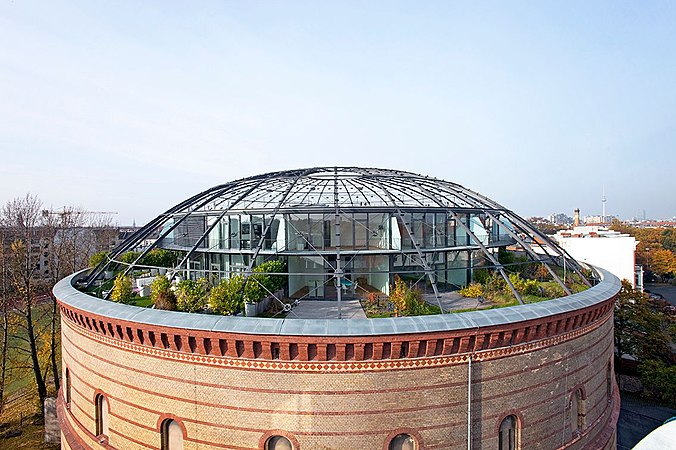Schwedler Dome

In 1851 Johann Wilhelm Schwedler opened a new chapter in structural engineering with his framework theory, which he developed independently of Karl Culmann (1821-1881), Squire Whipple (1804-1888) and Dmitri Iwanowitsch Schurawski (1821-1891). The truss theory was limited to flat systems until the end of the 19th century. Spatial support systems of structures such as industrial halls, train stations and bridges had an orthogonal structure, so that it was sufficient to break them down into flat systems. In addition, spatial engineering thinking had been trained since the beginning of the 19th century by the orthogonal projection method in the form of technical drawings, which dominated descriptive geometry . Schwedler was the first to overcome this problem of two-dimensional drawings with the brilliant power and clarity of his spatial perception - the “stereometric fantasy”, as he used to call this gift.
Also in the spatial domed load transfer was initially no consideration because the radially arranged binder with the aid of the planar structural were analyzed. Such a dome over the gas tank of the Imperial Continental Gas Association in Berlin (Hellweg No. 8 - today: Gitschiner Straße 19) collapsed in 1860 during assembly; Schwedler improved the dome construction, which was rebuilt a year later, but went the conventional way. For the same client, with the dome over the gas tank at Holzmarktstrasse 28 in Berlin, he was the first engineer to make the transition to the spatial dome, which was to go down in specialist literature as the Schwedler dome. At the meeting of the Berlin Architects' Association on January 31, 1863, Schwedler gave a lecture on the theory of the domed vault on which his static calculation was based; on May 23, 1863 he reported there about his new type of dome construction and invited the architects' association to visit it. Fig. 1 shows the development history of wide-span roofs over a polygonal floor plan, starting with wooden trusses supported by wrought iron tie rods, then replacing the wooden trusses with iron trusses (Fig. 2) and finally Schwedler's iron framework, which is shaped according to a cubic paraboloid of rotation (Fig. 3). To span the container diameter of 30.38 m, Schwedler only needs 20.6 t of iron - that's 28.4 kg / m².
In 1866, Schwedler reported on his first three-dimensional framework and five other Schwedler domes and not only created their theory, but also provided a simplified structural calculation method. Schwedler developed the membrane theory for axially symmetrically shaped and loaded shells and converted the membrane forces to the longitudes and latitudes. He transformed his highly statically indeterminate spatial framework into a calculable structural model by "smearing" the framework into a statically determined, rotationally symmetrical membrane shell, which can be described solely with the equilibrium conditions. What is predictable is built. Since 1863, the Schwedler domes enjoyed some popularity and formed an object of structural theory up until the middle of the last century. Schwedler himself realized numerous roofs with his dome system. Only two Schwedler domes should be mentioned here, which can still be admired today: the dome of the New Synagogue (Berlin-Mitte, Oranienburger Strasse 28–30; Fig. 5), which was built in 1863, and the roof of the municipal gas station in Fichtestrasse ( Gasometer Fichtestrasse ) in Berlin-Kreuzberg (Fig. 6). The last-named dome has a diameter of 54.9 m and a pitch of 12.2 m: For this, Schwedler only needed 68 t of iron, i.e. 28.7 kg / m². In this way, these strange webs of space and time let the distant light of history shine through ( Walter Benjamin ).
In his mastery of the structural composition of iron structures, Schwedler remained unsurpassed during his lifetime. The essential moment of this compositional process is its construction-oriented structural analysis, in the middle of which Schwedler places statically specific systems. In her book “From iron construction to steel construction” Ines Prokop headed the section on the establishment phase of structural engineering and iron construction (1850–1875) - d. H. the construction-oriented structural analysis - aptly with "'Statically determined' determines the structure". In the early 1860s, Schwedler became the protagonist of this development phase: the dome, which Schwedler had modeled into a rotationally symmetrical membrane shell, is a statically determined system; one for the construction practice even more important is the three-link system , which historically logical development in the 19th century Werner Lorenz out peeled
literature
- August Hertwig : Johann Wilhelm Schwedler. His life and his work. Wilhelm Ernst & Son , Berlin 1930.
- Karl-Eugen Kurrer : The History of the Theory of Structures. Searching for Equilibrium. Ernst & Sohn, Berlin 2018, p. 641ff.
- Ines Prokop: From iron construction to steel construction. Structures and their protagonists in Berlin 1850–1925. Berlin 2012, p. 61ff.
- Karl-Eugen Kurrer: The half-timbering conquers the third dimension: 150 years of the Schwedler Dome. Momentum magazine
Individual evidence
- ^ Martin Hoffman, Gerhard Drexel: Initiative Fichtebunker Berlin: Will the monument protection of the spruce bunker be sanded down in an investor-friendly way? The open PR portal, April 16, 2007, accessed on February 7, 2020 .
- ↑ Werner Lorenz: The development of the three-joint system in the 19th century. In: Stahlbau 59th vol., (1990), H. 1, pp. 1-10.




